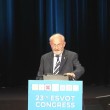
Roberto Poma ✝
DMV, DVSc, ACVIM (Neurology)
Associate Professor, Dept. of Clinical Studies
Ontario Veterinary College
University of Guelph
Guelph, ON, N1G2W1 Canada
"Though Dr. Roberto past-away, prematurely, we wish to continue to make available to readers, from the archives of Orthovet Supersite, his very charming and wise interview. This we do to honour the memory of a widely respected young man, an excellent neurologist, a fine man, husband and father."
G.S-S
G.S-S. You graduated in Italy and I wonder what you did after that, before you decided to come to Canada? What made you decide to emigrate? Did you plan to live and practice here or did you first come to look at the prospects for you and where did you take your neurological training?
R.P. I graduated in 1995 at the Faculty of Veterinary Medicine at the University of Turin, Italy. As soon as I terminated my studies, I decided to travel to North America for six months to observe different ways of practicing veterinary medicine and specifically veterinary neurology, meet people and gain experience in the field of veterinary electro-diagnosis. During this period of time, I visited several referral private practices in Michigan and Ontario and a few veterinary schools including the Ontario Veterinary College and Auburn University. This period of time has been my greatest professional experience and an invaluable resource that allowed me to radically change my vision and perspective on how to practice veterinary medicine, my future plans and I made a firm decision to enter a specialty residency training in veterinary neurology. This experience allowed me to forge my personality by meeting and knowing people of different culture, background and professional fields and by enhancing my capacity of interacting and opening my mind toward different ways of conducting personal and professional life. By the time that I went back to Italy, I knew it was a question of time before I was going to move back to North America and I continued to maintain contacts and exchanges until a neurology residency position became available at the Ontario Veterinary College in the summer of 1998. I applied successfully obtaining a three year position as a neurology resident under the supervision and guide of Dr. Joanne Parent, an exceptional mentor inside and outside my professional environment.
G.S-S. That being said, I feel sure that you have already embarked on some research projects. Please give readers, the majority being individuals who are full-time or part-time practicing veterinary orthopaedics surgeons, an outline of your special interests within neurology and, where appropriate, the results of your endeavours and how they would apply to the cases that they treat.
My research field focuses on the ‘diagnosis of epilepsy’. A few years ago, I received a large grant from the Canadian Foundation for Innovation to develop “a comparative canine epilepsy unit”. During these years, I and a few collaborators were able to set up a ‘canine epilepsy monitoring unit in the intensive care unit of the Ontario Veterinary College where long-term Electroencephalographic recordings are performed on critical epileptic patients. The epilepsy programme at our institution involves as well the use of a short-term and wireless EEG unit to record chronic epileptic patient in the hospital and in a home-environment setting. Additional research activities related to canine epilepsy include the use of specific MRI epilepsy protocols that allow the generation of curvilinear reconstructions of brain MRI of epileptic patients with sophisticated software analysis. The long-term plan of these clinically related research activities involve the determination of the ‘seizure focus’ in order to deliver in the future targeted therapeutic treatments such as surgical treatment of epileptogenic zones and delivering of repetitive Transcranial Magnetic Stimulation.
Another research activity currently undergoing in our neurology service at the Ontario Veterinary College involve the use of electrodiagnostic tests in Cavalier King Charles Spaniel (CKCS) dogs affected by syringomyelia (SM), a progressive conditioning causing severe neck pain and neuropathic pain that is typically caused by a suspected congenital malformation of the caudal portion of the cranial cavity, specifically the occipital bone. In the last three years we recruited 50 CKCS dogs with and without clinical signs of SM and we tested them with a series of electrodiagnostic tests including Transcranial Magnetic Motor Evoked Potentials, Spinal Evoked Potentials, Somatosensory Evoked Potentials and Brainstem Auditory Evoked Potentials. These tests are widely used in clinical neurology and are useful to investigate the functional integrity of the motor and sensory pathways of the central nervous system. The rational of this project is to determine if these tests are superior to MRI of the spinal cord to detect abnormalities in clinical and sub-clinical CKCS dogs with SM diagnosed by MRI.















